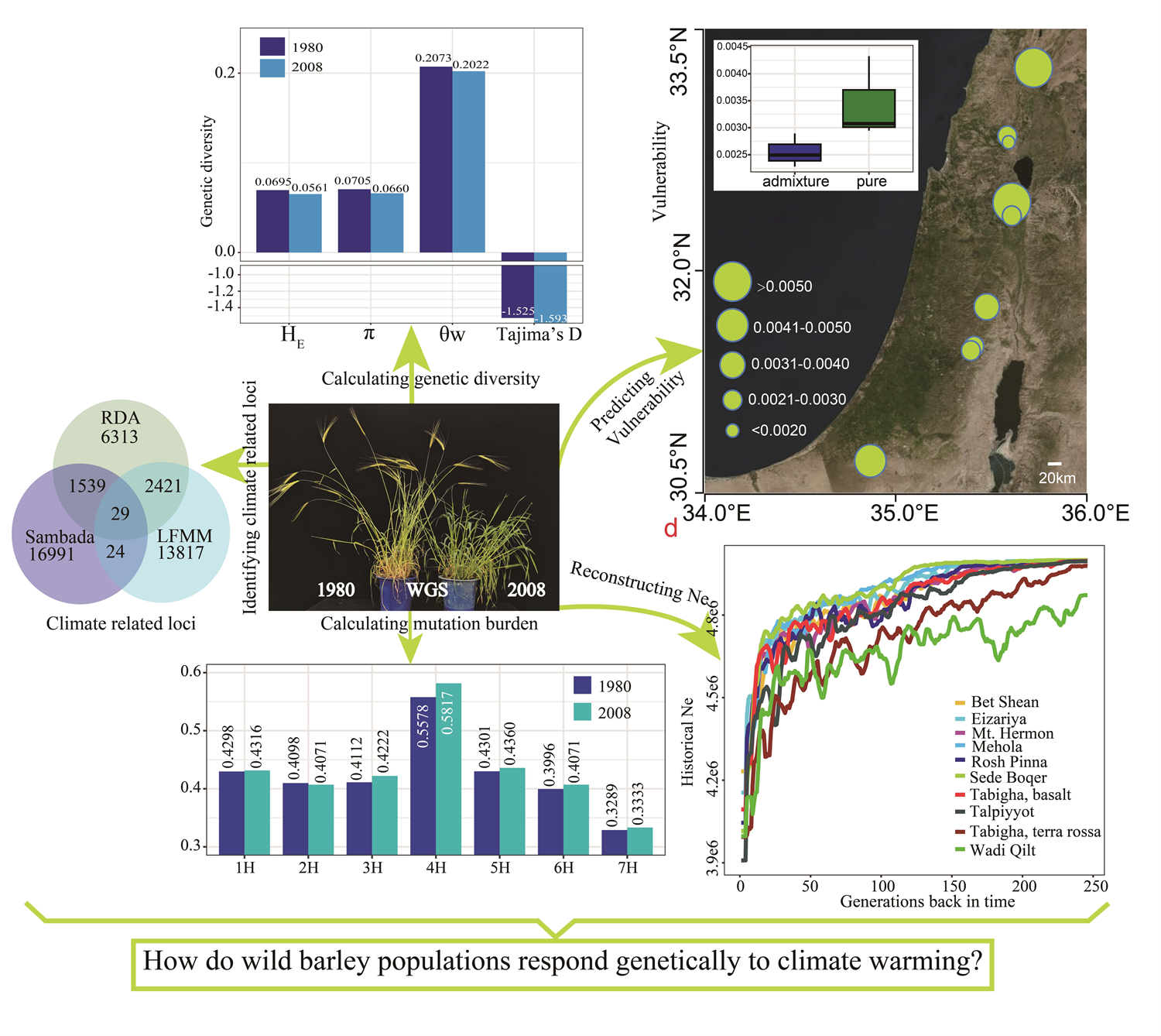南湖新闻网讯(通讯员 周羽)近日,我校任喜峰教授和孙东发教授团队结合基因组与环境的关联分析方法,解析了野生大麦群体响应气候变暖的遗传模式。该研究成果以“Genomic evidence for climate-linked diversity loss and increased vulnerability of wild barley spanning 28 years of climate warming” 发表在期刊Science of the Total Environment上。

野生大麦对气候变暖的遗传响应模式
大麦是世界上最早被驯化的禾谷类作物之一,其祖先——野生大麦(Hordeum. vulgare ssp. spontaneum)至今仍生长于近东新月沃地。该研究通过对1980年和2008年收集的野生大麦种群进行分析,发现经过28年的气候变暖,野生大麦的遗传多样性降低、选择压增高、有害突变比例和突变负荷增加。与环境关联分析后发现温度和湿度是影响野生大麦基因组变异的主要因素。同时,鉴定了包括过氧化物酶家族和热休克蛋白家族的690个与气候变量相关的基因,其中热休克蛋白家族HSP20基因HORVU2Hr1G120170在28年的气候变暖过程中处于强选择状态,推测其衍生的单倍型是野生大麦适应日益变暖环境的关键基因。另外,通过机器学习方法预测了2041至2100年碳排放背景下野生大麦群体的基因组脆弱性和对环境条件的遗传适应潜力。该研究不仅明确了气候变暖背景下大麦种群遗传响应的新模式,而且为野生种质资源的有效利用提供了指导。
据悉,我校作物遗传育种专业博士研究生周羽为第一作者,植物科学技术学院任喜峰教授为该论文的通讯作者。来自以色列海法大学的Eviatar Nevo教授、加拿大圣玛丽大学的Genlou Sun教授和兰州大学的李克欣教授对该研究提供了大力支持。本研究得到了现代农业产业技术体系项目的资助。
【英文摘要】
The information on how plant populations respond genetically to climate warming is scarce. Here, landscape genomic and machine learning approaches were integrated to assess genetic response of 10 wild barley (Hordeum vulgare ssp. spontaneum; WB) populations in the past and future, using whole genomic sequencing (WGS) data. The WB populations were sampled in 1980 and again in 2008. Phylogeny of accessions was roughly in conformity with sampling sites, which accompanied by admixture/introgressions. The 28-y climate warming resulted in decreased genetic diversity, increased selection pressure, and an increase in deleterious single nucleotide polymorphism (dSNP) numbers, heterozygous deleterious and total deleterious burdens for WB. Genome-environment associations identified some candidate genes belonging to peroxidase family (HORVU2Hr1G057450, HORVU4Hr1G052060 and HORVU4Hr1G057210) and heat shock protein 70 family (HORVU2Hr1G112630). The gene HORVU2Hr1G120170 identified by selective sweep analysis was under strong selection during the climate warming of the 28-y, and its derived haplotypes were fixed by WB when faced with the 28-y increasingly severe environment. Temperature variables were found to be more important than precipitation variables in influencing genomic variation, with an eco-physiological index gdd5 (growing degree-days at the baseline threshold temperature of 5 °C) being the most important determinant. Gradient forest modelling revealed higher predicted genomic vulnerability in Sede Boqer under future climate scenarios at 2041–2070 and 2071–2100. Additionally, estimates of effective population size (Ne) tracing back to 250 years indicated a forward decline in all populations over time. Our assessment about past genetic response and future vulnerability of WB under climate warming is crucial for informing conservation efforts for wild cereals and rational use strategies.
审核人 任喜峰
